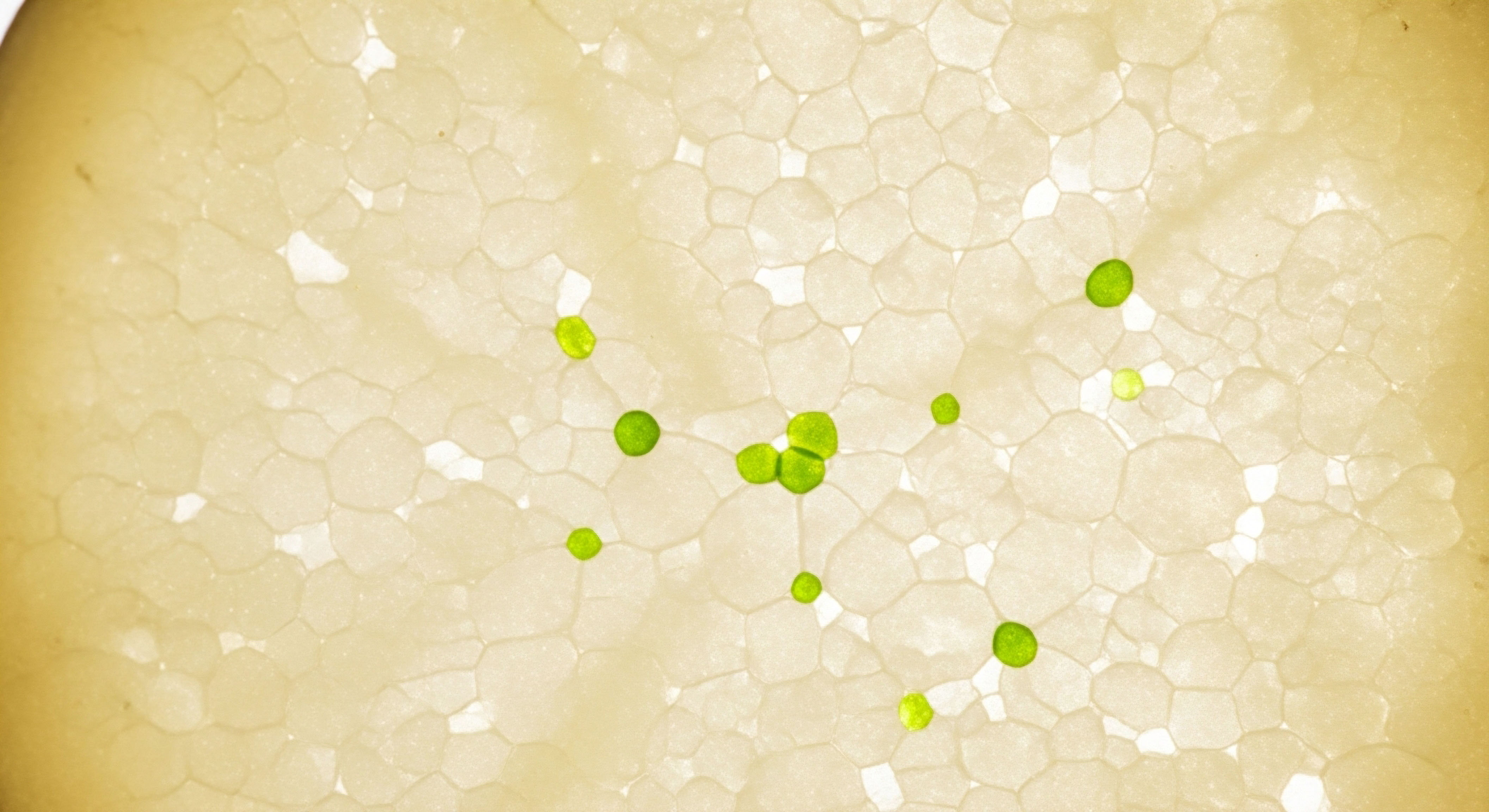

Fundamentals
You feel it in your energy, your mood, your sleep, and in the mirror. There is a sense of being out of sync with your own body, a feeling that the internal communication system has gone awry. This experience, this profound and personal dissonance, is often the first signal that your hormonal equilibrium has shifted.
When we discuss estrogen, we are speaking of one of the most powerful signaling molecules in the human body, a conductor of a vast biological orchestra. The question of whether dietary patterns can reverse an imbalance is a deeply personal one, because it asks if you can reclaim control over your own biological narrative.
The answer is grounded in the intricate mechanics of your physiology. Specific, targeted dietary choices can provide the raw materials and biological instructions to help your body recalibrate its own systems, particularly the metabolic machinery responsible for processing and clearing estrogen.
This process is not about finding a single magic food or a restrictive “cure.” It is about understanding the lifecycle of estrogen within your own unique system. Hormones are produced, they circulate and deliver their messages to cells, and then they must be broken down and safely escorted out of the body.
An imbalance occurs when this lifecycle is disrupted at any stage. Too much estrogen might be produced, or the body’s clearance systems might become sluggish, allowing estrogen to recirculate and continue delivering its message long after it should have ceased.
Your lived experience of symptoms like persistent fatigue, unexplained weight gain, mood volatility, or changes in your cycle is a direct reflection of this internal biochemical state. By providing your body with specific nutritional tools, you are directly supporting the organs and pathways that manage this delicate balance.
Understanding your body’s estrogen lifecycle is the first step toward using diet as a tool for hormonal recalibration.

The Estrogen Lifecycle a Biological Blueprint
To influence a system, one must first understand its design. Estrogen’s journey through the body is a continuous loop of creation, action, and deactivation. This process is primarily managed by two key organ systems the liver and the digestive tract. Think of them as the primary control centers for hormonal equilibrium. The foods you consume have a direct and measurable impact on the efficiency of these centers.
Initially, estrogens are synthesized in various tissues, most notably the ovaries in premenopausal women, but also in fat cells and adrenal glands. From there, they travel through the bloodstream to target tissues, binding to specific receptors on cells to exert their effects, which range from regulating the menstrual cycle to influencing bone density and cognitive function. This is the “active” phase of their life.
After their message has been delivered, these potent molecules must be deactivated. This critical process, known as detoxification or biotransformation, occurs predominantly in the liver. The liver converts active estrogens into water-soluble metabolites that can be eliminated from the body. This is a two-step process, referred to as Phase I and Phase II detoxification.
The efficiency of these pathways is directly influenced by the availability of specific nutrients found in your diet. A disruption here can lead to a buildup of potent estrogen forms, contributing to the symptoms of imbalance.

The Liver the Master Detoxification Hub
The liver is the central processing plant for hormonal clearance. During Phase I detoxification, enzymes known as the cytochrome P450 family modify the estrogen molecule. This step is crucial because it determines the type of estrogen metabolite that will be produced. Some metabolites are weaker and considered protective, while others are more potent and have been associated with increased risk for hormone-sensitive conditions. Specific dietary compounds can influence these pathways, encouraging the production of the more favorable metabolites.
Following Phase I, the estrogen metabolites move into Phase II detoxification. Here, the liver attaches specific molecules to them in a process called conjugation. This step effectively “tags” the estrogens, neutralizing them and making them water-soluble so they can be prepared for excretion.
These conjugated estrogens are then sent to the gallbladder to be released with bile into the small intestine, from where they will eventually be eliminated in the stool. A diet lacking the nutrients that support Phase II can create a bottleneck, causing estrogen metabolites to accumulate.

The Gut Microbiome the Final Gatekeeper
The journey of estrogen does not end in the liver. Once the conjugated, “deactivated” estrogens enter the intestines, a new set of players comes into focus ∞ the trillions of bacteria that make up your gut microbiome. This ecosystem contains a specific collection of bacteria with genes capable of metabolizing estrogens, a community scientists have named the “estrobolome.”
The estrobolome produces an enzyme called beta-glucuronidase. This enzyme can “snip” off the tag that the liver attached during Phase II detoxification. This action reverts the estrogen back into its active form. When this happens, the now-active estrogen can be reabsorbed from the gut back into the bloodstream, increasing the body’s total estrogen load.
A healthy, balanced gut microbiome keeps beta-glucuronidase activity in check, ensuring that deactivated estrogens are properly excreted. An imbalanced microbiome, or dysbiosis, can lead to excessive beta-glucuronidase activity, promoting the recirculation of estrogen and undermining the liver’s hard work. Therefore, nurturing a healthy gut environment is a fundamental pillar of maintaining estrogen balance.


Intermediate
Moving from the foundational understanding of estrogen’s lifecycle to a practical application involves targeted dietary strategies. These protocols are designed to directly support the two primary systems of hormonal regulation ∞ the liver’s detoxification pathways and the gut’s microbiome. Specific foods contain bioactive compounds that act as signals, providing the precise instructions your body needs to manage estrogen metabolism effectively.
Adopting these dietary patterns is an act of providing your biological machinery with high-quality raw materials to perform its job optimally.

Modulating Liver Detoxification through Diet
The liver’s capacity to safely process estrogen is not static; it is highly dependent on nutrient availability. The goal of a hormone-balancing diet is to enhance both Phase I and Phase II detoxification, steering estrogen down the most beneficial metabolic pathways and ensuring its efficient removal. This is where the strategic inclusion of certain food groups becomes a powerful therapeutic tool.

The Power of Cruciferous Vegetables
Cruciferous vegetables, such as broccoli, cauliflower, cabbage, and Brussels sprouts, are uniquely potent in their ability to modulate estrogen metabolism. Their therapeutic action comes from sulfur-containing compounds called glucosinolates. When you chop or chew these vegetables, an enzyme called myrosinase is released, which converts glucosinolates into several bioactive compounds, most notably Indole-3-Carbinol (I3C).
In the acidic environment of the stomach, I3C is converted into other molecules, including 3,3′-Diindolylmethane (DIM). Both I3C and DIM have a profound effect on the liver’s Phase I detoxification pathway. They act as signaling molecules that encourage the cytochrome P450 enzymes to preferentially convert estrogen into a weaker metabolite called 2-hydroxyestrone (2-OHE1), rather than the more potent and potentially problematic 16-alpha-hydroxyestrone (16a-OHE1).
A higher ratio of 2-OHE1 to 16a-OHE1 is associated with healthier estrogen balance. Consuming cruciferous vegetables regularly provides the liver with the direct instructions to favor this protective pathway.
Cruciferous vegetables provide compounds like I3C and DIM, which guide the liver to produce less potent, more favorable estrogen metabolites.
Furthermore, the compounds in cruciferous vegetables also support Phase II detoxification. They provide the sulfur-containing molecules necessary for the sulfation pathway, one of the key conjugation methods the liver uses to neutralize estrogens and prepare them for excretion. By supporting both phases, these vegetables ensure a smooth and efficient flow of estrogen through the liver’s entire clearance system.
Here is a breakdown of key cruciferous vegetables and their role:
- Broccoli and Broccoli Sprouts ∞ Particularly rich in glucoraphanin, a precursor to sulforaphane, which is a powerful activator of Phase II detoxification enzymes.
- Brussels Sprouts ∞ Among the most potent sources of glucosinolates, providing a significant dose of the precursors to I3C.
- Kale and Collard Greens ∞ These leafy greens are not only rich in glucosinolates but also provide magnesium and B vitamins, which are essential cofactors for liver enzymes.
- Cabbage ∞ A traditional food that provides a substantial amount of glucosinolates and fiber, supporting both liver and gut health.

Optimizing Gut Health and the Estrobolome
The gut is the final checkpoint for estrogen excretion. A healthy gut microbiome ensures that estrogens deactivated by the liver are successfully removed from the body. An unhealthy gut, in contrast, can actively reverse this process. Dietary interventions for gut health focus on two key areas ∞ promoting a diverse and beneficial microbial population and ensuring the efficient transit of waste.

The Critical Role of Dietary Fiber
Dietary fiber is arguably the most important nutritional tool for managing estrogen levels via the gut. Fiber works through two distinct mechanisms. First, certain types of fiber, particularly soluble fiber, form a gel-like substance in the intestines. This gel can bind directly to conjugated estrogens in the gut, physically preventing them from being reabsorbed and ensuring they are carried out with the stool. This simple mechanical action can significantly reduce the amount of estrogen that re-enters circulation.
Second, and perhaps more importantly, fiber is the primary fuel source for beneficial gut bacteria. These bacteria ferment fiber to produce short-chain fatty acids (SCFAs) like butyrate, which is the main energy source for the cells lining the colon and helps maintain a healthy gut barrier.
By feeding these beneficial microbes, you encourage their growth and create a gut environment that is less hospitable to the bacteria that produce high levels of beta-glucuronidase. A diet rich in fiber systematically lowers the activity of this enzyme, thereby reducing the de-conjugation and reabsorption of estrogen. Studies have consistently shown that higher fiber intake is associated with lower circulating estrogen levels.
| Fiber Type | Primary Function | Food Sources |
|---|---|---|
| Soluble Fiber | Binds to bile and estrogens; slows digestion. | Oats, barley, apples, citrus fruits, carrots, beans, psyllium husk, flax seeds. |
| Insoluble Fiber | Increases stool bulk; promotes regular bowel movements. | Whole wheat, nuts, seeds, cauliflower, green beans, potatoes. |

Introducing Phytoestrogens a Modulating Influence
Phytoestrogens are plant-derived compounds that have a chemical structure similar to human estrogen, allowing them to interact with estrogen receptors in the body. This can sound alarming, but their effect is generally much weaker than that of endogenous estrogen. Their therapeutic value lies in their ability to act as selective estrogen receptor modulators (SERMs).
In a state of high estrogen, phytoestrogens can bind to estrogen receptors, blocking the more potent human estrogen from binding. This can help to buffer the body from excessive estrogenic stimulation. In a state of low estrogen, such as during menopause, these same compounds can provide a mild estrogenic signal, helping to alleviate some symptoms of deficiency.
The two main classes of phytoestrogens relevant to this discussion are:
- Lignans ∞ Found in the highest concentrations in flax seeds, sesame seeds, and other whole grains. Gut bacteria convert plant lignans into enterolactone and enterodiol, the forms that are active in the human body. These compounds have been shown to modulate estrogen metabolism and are associated with a healthier hormonal profile.
- Isoflavones ∞ Abundant in soy products (tofu, tempeh, edamame) and other legumes. The isoflavones genistein and daidzein are well-researched for their SERM activity. The ability to metabolize these compounds effectively, particularly converting daidzein to a more potent compound called equol, depends on having the right gut bacteria, which varies among individuals.
Incorporating a moderate amount of whole-food sources of phytoestrogens, especially ground flax seeds, can be a beneficial part of a comprehensive dietary strategy. They provide a gentle, modulating effect on the estrogen system.


Academic
A sophisticated approach to dietary intervention for estrogen imbalance requires a systems-biology perspective. This view recognizes that estrogen metabolism is not an isolated pathway but is deeply integrated with other core physiological systems, including gut microbial ecology, hepatic biotransformation, and systemic inflammation.
The central thesis is that specific dietary patterns can reverse estrogen imbalances by modulating the genetic expression and enzymatic activity of the estrobolome, the collection of gut microbial genes capable of metabolizing estrogens. Altering the composition of the microbiome through diet directly influences the level of circulating estrogens and their downstream effects.

The Estrobolome as a Therapeutic Target
The estrobolome functions as a critical endocrine organ, regulating the enterohepatic circulation of estrogens. After the liver conjugates estrogens, primarily through glucuronidation, these inactive metabolites are excreted into the gut via bile. Here, certain gut microbes, possessing the gene that codes for the β-glucuronidase enzyme, can deconjugate these estrogens, effectively reactivating them.
These unconjugated, active estrogens are then reabsorbed into circulation, contributing to the body’s total estrogen burden. Dysbiosis, an imbalance in the gut microbiota characterized by an over-representation of β-glucuronidase-producing bacteria (such as certain species of Clostridium and Escherichia ), leads to elevated estrogen levels and is associated with a higher risk of estrogen-dependent pathologies.
Dietary fiber is the principal modulator of the estrobolome. A high-fiber diet promotes the proliferation of saccharolytic (fiber-fermenting) bacteria, such as Bifidobacterium and Lactobacillus. These species tend to produce lower levels of β-glucuronidase and, through competitive exclusion and the production of antimicrobial peptides, can suppress the growth of pathogenic, high-β-glucuronidase-producing bacteria.
Furthermore, the fermentation of fiber produces short-chain fatty acids (SCFAs), which lower the colonic pH, creating an environment that is less favorable for the activity of the β-glucuronidase enzyme. Clinical data supports this mechanism; studies have demonstrated an inverse correlation between dietary fiber intake and serum estrogen concentrations, mediated by changes in fecal microbial composition and reduced β-glucuronidase activity.
Targeting the estrobolome with prebiotic fiber and probiotics is a direct, evidence-based strategy for reducing estrogen reactivation in the gut.

How Does Diet Influence Estrogen Detoxification Pathways?
The detoxification of estrogen in the liver is a highly regulated enzymatic process that can be manipulated by dietary components. Phase I metabolism is dominated by cytochrome P450 (CYP) enzymes, specifically CYP1A1, CYP1B1, and CYP3A4. These enzymes hydroxylate estradiol (E2) and estrone (E1) at different positions, creating distinct metabolites with varying biological activities.
- The 2-Hydroxylation Pathway (CYP1A1/1A2) ∞ This pathway produces 2-hydroxyestrone (2-OHE1), a metabolite with very weak estrogenic activity and potential anti-proliferative properties.
- The 4-Hydroxylation Pathway (CYP1B1) ∞ This pathway produces 4-hydroxyestrone (4-OHE1), which can generate reactive quinones that cause DNA damage, and is considered a more carcinogenic route.
- The 16α-Hydroxylation Pathway (CYP3A4) ∞ This pathway generates 16α-hydroxyestrone (16α-OHE1), a potent estrogenic metabolite that promotes cell proliferation.
The ratio of 2-OHE1 to 16α-OHE1 is often used as a biomarker for estrogen-related health risk. A higher ratio is considered protective. Indole-3-carbinol (I3C) and its dimer, DIM, from cruciferous vegetables are potent inducers of the CYP1A1 enzyme, thereby upregulating the 2-hydroxylation pathway and shifting estrogen metabolism toward the production of the less estrogenic 2-OHE1 metabolite. This has been demonstrated in human clinical trials where supplementation with I3C significantly increased the urinary 2-OHE1/16α-OHE1 ratio.
Phase II metabolism, which involves conjugation reactions like glucuronidation, sulfation, and methylation, is equally critical. The goal of Phase II is to render the estrogen metabolites water-soluble for excretion. The methylation of catechol estrogens (2-OHE1 and 4-OHE1) by the enzyme Catechol-O-methyltransferase (COMT) is particularly important, as it deactivates these potentially reactive molecules.
The function of COMT requires cofactors like magnesium and methyl donors from the diet, such as methionine, folate (B9), B12, and B6. A diet rich in leafy greens, legumes, and lean protein provides these essential cofactors, supporting the complete and safe detoxification of estrogen.
| Pathway | Key Nutrients/Compounds | Dietary Sources | Mechanism of Action |
|---|---|---|---|
| Phase I (2-Hydroxylation) | Indole-3-Carbinol (I3C), DIM | Broccoli, cauliflower, cabbage, Brussels sprouts | Upregulates CYP1A1 enzyme activity, increasing protective 2-OHE1 production. |
| Phase II (Methylation) | Magnesium, Folate (B9), Vitamin B12, Vitamin B6, Methionine | Leafy greens, legumes, nuts, seeds, lean protein, eggs | Serve as essential cofactors for the COMT enzyme, which neutralizes catechol estrogens. |
| Phase II (Sulfation) | Sulfur-containing amino acids (cysteine, methionine) | Cruciferous vegetables, garlic, onions, eggs, lean protein | Provide sulfur groups required for the SULT enzymes to conjugate estrogens. |
| Phase II (Glucuronidation) | Calcium-D-Glucarate | Apples, oranges, grapefruit, cruciferous vegetables | Inhibits β-glucuronidase in the gut, preventing deconjugation of glucuronidated estrogens. |

What Is the Connection between Insulin Resistance and Estrogen?
A systems-level analysis reveals a bidirectional relationship between estrogen balance and insulin sensitivity. Estrogen itself influences glucose metabolism and insulin action. However, a state of chronic hyperinsulinemia and insulin resistance, often driven by a diet high in refined carbohydrates and processed foods, can exacerbate estrogen imbalance.
High insulin levels can increase the production of androgens in the ovaries, which are then converted into estrogen in fat tissue by the aromatase enzyme. Since insulin resistance promotes fat storage, it also increases the amount of aromatase-containing tissue, leading to greater estrogen production outside of the ovaries.
This creates a vicious cycle where insulin resistance drives up estrogen, and the resulting hormonal milieu can further impair metabolic function. A dietary pattern that stabilizes blood sugar and improves insulin sensitivity ∞ one based on whole foods, adequate protein, healthy fats, and high fiber ∞ is therefore a non-negotiable component of any protocol aimed at reversing estrogen imbalance. This approach addresses a core driver of hormonal disruption, going beyond simply managing the downstream effects.

References
- Michnovicz, H. J. & Bradlow, H. L. (1990). Altered estrogen metabolism and excretion in humans following consumption of indole-3-carbinol. Nutrition and Cancer, 16 (1), 59-66.
- Fowke, J. H. Longcope, C. & Hebert, J. R. (2000). Brassica vegetable consumption shifts estrogen metabolism in healthy postmenopausal women. Cancer Epidemiology, Biomarkers & Prevention, 9 (8), 773-779.
- Baker, J. M. Al-Nakkash, L. & Herbst-Kralovetz, M. M. (2017). Estrogen ∞ gut microbiome axis ∞ Physiological and clinical implications. Maturitas, 103, 45-53.
- Kwa, M. Plottel, C. S. Blaser, M. J. & Adams, S. (2016). The Intestinal Microbiome and Estrogen Receptor-Positive Breast Cancer. Journal of the National Cancer Institute, 108 (8).
- Setchell, K. D. & Clerici, C. (2010). Equol ∞ history, chemistry, and formation. The Journal of nutrition, 140 (7), 1355S-1362S.
- Zengul, A. G. (2019). Exploring The Link Between Dietary Fiber, The Gut Microbiota And Estrogen Metabolism Among Women With Breast Cancer. UAB Digital Commons.
- Monroe, K. R. et al. (2004). High fiber intake reduces estrogen levels in Latina women. American Association for Cancer Research Frontiers in Cancer Research Prevention Meeting.
- Plottel, C. S. & Blaser, M. J. (2011). Microbiome and malignancy. Cell host & microbe, 10 (4), 324-335.
- Bradlow, H. L. Telang, N. T. Sepkovic, D. W. & Osborne, M. P. (1996). 2-hydroxyestrone ∞ the ‘good’ estrogen. Journal of Endocrinology, 150 (Supplement), S259-S265.
- Gaskins, A. J. Mumford, S. L. Zhang, C. Wactawski-Wende, J. Hovey, K. M. Whitcomb, B. W. & Schisterman, E. F. (2009). Effect of daily fiber intake on reproductive function ∞ the BioCycle Study. The American journal of clinical nutrition, 90 (4), 1061-1069.

Reflection

Your Biology Is a Conversation
The information presented here is more than a set of dietary rules; it is an invitation to begin a new kind of conversation with your body. The symptoms you may be experiencing are not a sign of a broken system, but a message from a highly intelligent system that is responding to its environment.
The foods you choose are a primary component of that environment. Each meal is an opportunity to send a signal of support, to provide the precise biochemical information your body needs to restore its own innate balance. This journey of reclaiming your vitality is one of profound self-awareness.
It requires listening to the feedback your body provides, observing the shifts in energy and well-being as you change your inputs, and recognizing that you are an active participant in your own health. The knowledge of how these systems work is the map; your personal experience is the compass. Trust in the process of providing your body with what it needs to function, and allow it to guide you toward a state of renewed equilibrium and strength.

Glossary

dietary patterns

providing your body with

estrogen metabolites

gut microbiome

estrobolome

beta-glucuronidase

the estrobolome

estrogen balance

estrogen metabolism

cruciferous vegetables

indole-3-carbinol

dim

estrogen levels

dietary fiber

fiber intake

phytoestrogens




